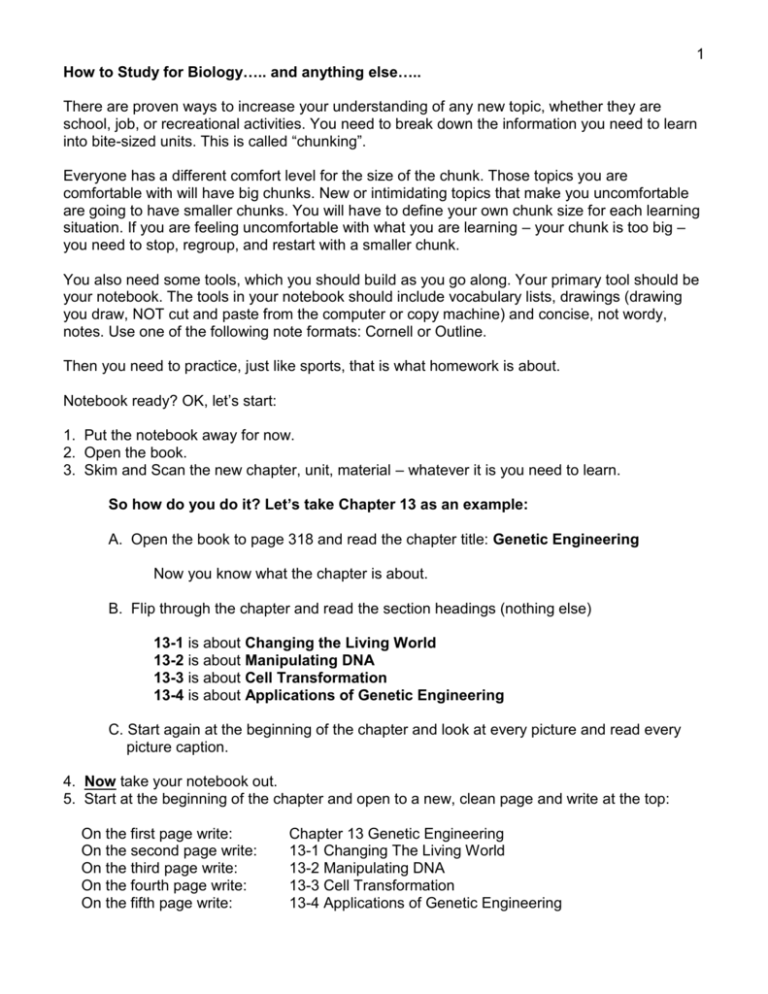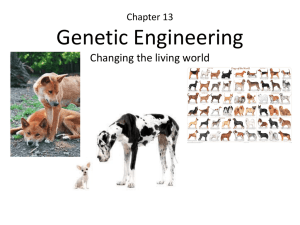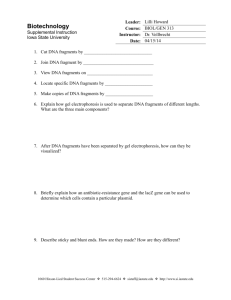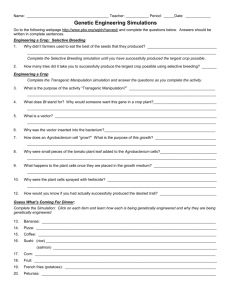There are proven ways to increase your understanding of any new
advertisement

1 How to Study for Biology….. and anything else….. There are proven ways to increase your understanding of any new topic, whether they are school, job, or recreational activities. You need to break down the information you need to learn into bite-sized units. This is called “chunking”. Everyone has a different comfort level for the size of the chunk. Those topics you are comfortable with will have big chunks. New or intimidating topics that make you uncomfortable are going to have smaller chunks. You will have to define your own chunk size for each learning situation. If you are feeling uncomfortable with what you are learning – your chunk is too big – you need to stop, regroup, and restart with a smaller chunk. You also need some tools, which you should build as you go along. Your primary tool should be your notebook. The tools in your notebook should include vocabulary lists, drawings (drawing you draw, NOT cut and paste from the computer or copy machine) and concise, not wordy, notes. Use one of the following note formats: Cornell or Outline. Then you need to practice, just like sports, that is what homework is about. Notebook ready? OK, let’s start: 1. Put the notebook away for now. 2. Open the book. 3. Skim and Scan the new chapter, unit, material – whatever it is you need to learn. So how do you do it? Let’s take Chapter 13 as an example: A. Open the book to page 318 and read the chapter title: Genetic Engineering Now you know what the chapter is about. B. Flip through the chapter and read the section headings (nothing else) 13-1 is about Changing the Living World 13-2 is about Manipulating DNA 13-3 is about Cell Transformation 13-4 is about Applications of Genetic Engineering C. Start again at the beginning of the chapter and look at every picture and read every picture caption. 4. Now take your notebook out. 5. Start at the beginning of the chapter and open to a new, clean page and write at the top: On the first page write: On the second page write: On the third page write: On the fourth page write: On the fifth page write: Chapter 13 Genetic Engineering 13-1 Changing The Living World 13-2 Manipulating DNA 13-3 Cell Transformation 13-4 Applications of Genetic Engineering 2 6. Return to the beginning of the chapter in the book and open your notebook to the first page for Chapter 13. A. Go to page 319, to the side column titled “Guide for Reading” and read the “Key Concepts” for the section, the vocabulary words (just read them), and any other information included. Do this for every Section in the chapter. B. Now define the vocabulary words. Use the page labeled “Chapter 13” for the vocabulary words for each section. Hand write each vocabulary word and definition. Alternate ways for you to learn the vocabulary include: Flashcards Insert Vocabulary at the beginning of your notes for each section C. Go to the page in your notebook titled “13-1 Changing the Living World” and copy the blue headings (leave space for notes) into the left hand column for Cornell notes, or as subcategories for outline notes. For 13-1 this will include: Selective Breeding Increasing Variation D. Now read and take notes. Keep your notes concise – Don’t recopy the text, summarize! E. Repeat for every section in the chapter. 7. Assessment – Did I learn it? Your textbook CD has quizzes for each section and then mini-tests for each chapter. Use them! These quizzes will correct themselves, you will immediately know if you entered the right answer. Better yet, there are “Hints” that will immediately link you back to the answers in the online textbook. 8. Other resources: My website has outline skeletons already prepared for each chapter. If you like outlining – use them. My website links you to the textbook webpages. The textbook webpages have additional links and online quizzes 3 Chapter 13 Genetic Engineering Selective Breeding Hybridization Inbreeding Polyploid Genetic Engineering Restriction Enzyme Gel Electrophoresis The breeding of only those plants or animals which have desired characteristics, so the characteristics are passes on to the next generation. Example: results in different breeds of dogs. Cross breeding dissimilar individuals hopefully resulting in offspring with the best traits of both parents Continued breeding of individual plants or animals with similar characteristics in order to maintain those characteristics Germ Cells (resulting in organisms) with double or triple the usual number of chromosomes Man made changes in the genetic code of a living organism Amazingly precise enzymes that cut DNA at very specific locations, resulting in DNA fragments with “sticky ends” A method of separating DNA fragments by placing them in a porous gel and running an electric current through the gel. The fragments are pulled through the gel, the smaller fragments moving faster, which separates the fragments. Continue vocab definitions in this format 4 13-1 Changing The World Selective Breeding Controlled breeding to enhance desired characteristics. Been done for 10,000 years Results in breed of plants & animals o e.g. breeds of dogs, horses, cows, etc. Hybridization Breeding dissimilar individuals hoping to get offspring with good or better characteristics. Luther Burbank – 1849-1926 o Created disease resistant potatoes o + over 800 other hybrids useful to man Inbreeding Breeding similar individuals to maintain desired characteristics, e.g. breeds of dogs Risky o Can result in the concentration of bad as well as good characteristics, e.g. Hip displasia in German Shepards Hyperactivity in Irish Setters Blindness in Golden Retrievers Increasing Requires genetic diversity Variation Natural Artificial through induced mutations using o Radiation o Chemicals o Works well with bacteria Produced bacteria that eat oil o Produces new species of plants Can happen naturally or be induced polyploidy Polyploidy Tolerated in plants, poorly tolerated in animals 5 13-2 Manipulating DNA Tools of Molecular Biology Steps in Genetic Engineering 1. DNA Extraction Cells are broken open and DNA is separated 2. Cutting DNA See figure 13-5 on page 322 DNA is cut into fragments using: o Restriction Enzymes Hundreds have been discovered Each cuts DNA differently Very precise Each end of fragment has “sticky ends” 3. Separate Fragments Page 322 Gel Electrophoresis o Electric current pulls fragments thru gel o Smaller fragments move faster o Results in separation of fragments by size o Can be used to locate and identify genes Hopefully you get the idea








